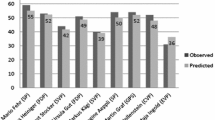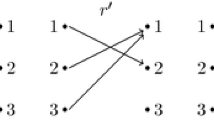Abstract
The distinction – in fact, rivalry – between two intuitive notions about what constitutes the winning candidates or policy alternatives has been present in the social choice literature from its Golden Age, i.e. in the late 18’th century [13]. According to one of them, the winners can be distinguished by looking a the performance of candidates in one-on-one, that is, pairwise contests. According to the other, the winners are in general best situated in the evaluators’ rankings over all candidates. The best known class of rules among those conforming to the first intuitive notion are those that always elect the Condorcet winner whenever one exists. These rules are called Condorcet extensions for the obvious reason that they extend Condorcet’s well-known winner criterion beyond the domain where it can be directly applied. A candidate is a Condorcet winner whenever it defeats all other candidates in pairwise contests with a majority of votes. Condorcet extensions specify winners in all settings including those where a Condorcet winner is not to be found. Of course, in those settings where there is a Condorcet winner they all end up with electing it.
Useful remarks of the referees on an earlier version are gratefully acknowledged.
Access this chapter
Tax calculation will be finalised at checkout
Purchases are for personal use only
Similar content being viewed by others
Notes
- 1.
Several variations of the criterion can be envisioned. To wit, one could call a candidate the Condorcet winner whenever he/she wins all contestants with more than 50% of the votes, or by some other qualified majority of votes. One can also determine the winner is pairwise contests by some other criterion like, for instance, the number of goals in football or time spent in skating a fixed distance, etc.
- 2.
The descriptive accuracy of assuming complete and transitive preference relations can be and has been questioned, but in the present context we shall not dwell on the issue (see, e.g. [20]).
- 3.
Fishburn makes the valid point that it is not entirely fair to Dodgson to name the rule after him since he suggested several other rules and suggested counting preference switches only as a component of a more complex procedure [10]. Also Tideman questions the plausibility of associating Dodgson with this rule [24]. See [3]. Keeping these caveats in mind we shall, however, conform to the standard usage of the concept of Dodgson’s rule.
- 4.
Note that the NER winner C is defeated by B in a pairwise majority comparison. Hence C is not in the core.
References
Bartholdi, J., Tovey, C., Trick, M.: Voting schemes for which it can be difficult to tell who won the election. Soc. Choice Welf. 6, 157–165 (1989)
Black, D.: The Theory of Committees and Elections. Cambridge University Press, Cambridge (1958)
Brandt, F.: Some remarks on Dodgson’s voting rule. Math. Log. Q. 55, 460–463 (2009)
Caragiannis, I., Hemaspaandra, E., Hemaspaandra, L.: Dodgson’s rule and Young’s rule. In: Brandt, F., Conitzer, V., Endriss, U., Lang, J., Procaccia, A. (eds.) Handbook of Computational Social Choice, pp. 103–126. Cambridge University Press, New York (2016)
Felsenthal, D.S., Nurmi, H.: Monotonicity Failures Afflicting Procedures for Electing a Single Candidate. SE. Springer, Cham (2017). https://doi.org/10.1007/978-3-319-51061-3
Felsenthal, D.S., Nurmi, H.: Monotonicity violations by Borda elimination and Nanson’s rules: a comparison Group Decis. Negot. 27, 637–664 (2018)
Felsenthal, D.S., Tideman, N.: Varieties of failure of monotonicity and participation under five voting methods. Theory Decis. 75, 59–77 (2013)
Felsenthal, D.S., Tideman, N.: Interacting double monotonicity failure with direction of impact under five voting rules. Math. Soc. Sci. 67, 57–66 (2014)
Fishburn, P.C.: The Theory of Social Choice. Princeton University Press, Princeton (1973)
Fishburn, P.C.: Condorcet social choice functions. SIAM J. Appl. Math. 33, 469–489 (1977)
Fishburn, P.C.: Monotonicity paradoxes in the theory of elections. Discret. Appl. Math. 4, 119–134 (1982)
Fishburn, P.C.: A note on “A note on Nanson’s rule”. Public Choice 64, 101–102 (1990)
McLean, I., Urken, A. (eds.): Classics of Social Choice. The University of Michigan Press, Ann Arbor (1995)
Moulin, H.: Condorcet’s principle implies the no-show paradox. J. Econ. Theory 45, 53–64 (1988)
Nanson, E.J.: Methods of election. Trans. Proc. R. Soc. Vic., Art. XIX, 197–240 (1883)
Niou, E.M.S.: A note on Nanson’s rule. Public Choice 54, 191–193 (1987)
Nurmi, H.: Comparing Voting Systems. D. Reidel, Dordrecht (1987)
Nurmi, H.: On Nanson’s method. In: Apunen, O., Borg, O., Hakovirta, H., Paastela, J. (eds.) Democracy in the Modern World. Essays for Tatu Vanhanen, Series A, vol. 260, pp. 199–210. Acta Universitatis Tamperensis, Tampere (1989)
Nurmi, H.: Monotonicity and its cognates in the theory of choice. Public Choice 121, 25–49 (2004)
Nurmi, H.: Are we done with preference rankings? If we are, then what? Oper. Res. Decis. 24, 63–74 (2014)
Pérez, J.: The strong no show paradoxes are a common flaw in Condorcet voting correspondences. Soc. Choice Welf. 18, 601–616 (2001)
Saari, D.G.: Basic Geometry of Voting. Springer, Heidelberg (1995). https://doi.org/10.1007/978-3-642-57748-2
Schwartz, T.: The Logic of Collective Choice. Columbia University Press, New York (1986)
Tideman, N.: Independence of clones as a criterion for voting rules. Soc. Choice Welf. 4, 185–206 (1987)
Author information
Authors and Affiliations
Corresponding author
Editor information
Editors and Affiliations
Rights and permissions
Copyright information
© 2018 Springer-Verlag GmbH Germany, part of Springer Nature
About this chapter
Cite this chapter
Nurmi, H. (2018). Reflections on Two Old Condorcet Extensions. In: Nguyen, N., Kowalczyk, R., Mercik, J., Motylska-Kuźma, A. (eds) Transactions on Computational Collective Intelligence XXXI. Lecture Notes in Computer Science(), vol 11290. Springer, Berlin, Heidelberg. https://doi.org/10.1007/978-3-662-58464-4_2
Download citation
DOI: https://doi.org/10.1007/978-3-662-58464-4_2
Published:
Publisher Name: Springer, Berlin, Heidelberg
Print ISBN: 978-3-662-58463-7
Online ISBN: 978-3-662-58464-4
eBook Packages: Computer ScienceComputer Science (R0)




